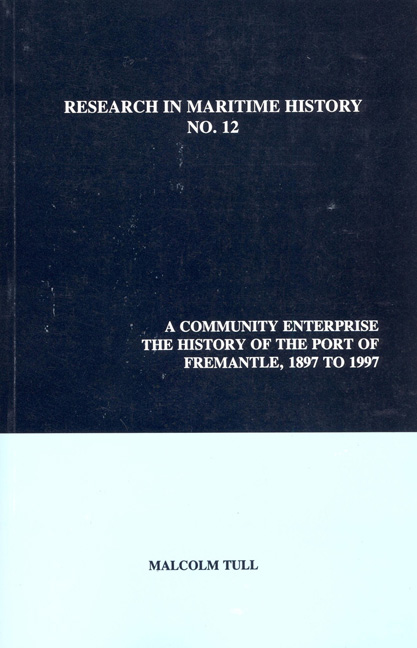Book contents
- Frontmatter
- Table of Contents
- List of Tables
- List of Figures
- List of Photos
- Acknowledgements
- Abbreviations
- Conversions
- Introduction
- Chapter 1 The Birth of A Modern Port
- Chapter 2 The Establishment of The Fremantle Harbour Trust
- Chapter 3 The Development Of Trade At The Port of Fremantle
- Chapter 4 The Shipping of Fremantle
- Chapter 5 A Century of Port Development, 1897 To 1997
- Chapter 6 Cargo-Handling Technology, Working Conditions And Industrial Relations on The Fremantle Waterfront
- Chapter 7 From Port Authority To Strategic Manager: The Transformation of The FPA
- Appendix A Trade and Shipping Statistics
- Appendix B Financial Statistics
- Appendix C Labour Statistics
- Appendix D
- Bibliography
- Index
Introduction
- Frontmatter
- Table of Contents
- List of Tables
- List of Figures
- List of Photos
- Acknowledgements
- Abbreviations
- Conversions
- Introduction
- Chapter 1 The Birth of A Modern Port
- Chapter 2 The Establishment of The Fremantle Harbour Trust
- Chapter 3 The Development Of Trade At The Port of Fremantle
- Chapter 4 The Shipping of Fremantle
- Chapter 5 A Century of Port Development, 1897 To 1997
- Chapter 6 Cargo-Handling Technology, Working Conditions And Industrial Relations on The Fremantle Waterfront
- Chapter 7 From Port Authority To Strategic Manager: The Transformation of The FPA
- Appendix A Trade and Shipping Statistics
- Appendix B Financial Statistics
- Appendix C Labour Statistics
- Appendix D
- Bibliography
- Index
Summary
Ports are vital links in the international transport system and, for an island nation such as Australia, assume a special importance as gateways to the rest of the world. The basic function of a port is to provide a link between land and sea transport and to furnish means by which transfers of freight and passengers between the two systems can be made efficiently. A port is
the place of contact between land and maritime space, and it provides services to both hinterland and maritime organisation. It is, therefore, a knot where ocean and inland transport lines meet and intertwine.
But a port is not merely a “knot” where land and sea transport intertwines: it can also be a centre of population and of political, economic and social activity. During the nineteenth century Asian ports such as Bombay, Singapore and Shanghai formed the hearts of cities which constituted the meeting places of European and indigenous cultures. Such ports facilitated western economic penetration into the less developed nations of the world. The Australian capital city ports that were established between 1788 and 1837 similarly provided the British Empire with gateways into the vast Australian continent. Australian ports, of course, never became cosmopolitan meeting places to the same degree as the Asian ports because the Aboriginal population was relatively small and, until after the Second World War, trade and shipping was mostly with Britain.
The Port of Fremantle, which is located on the edge of the Indian Ocean, was developed to provide a gateway to the western part of the continent. The port has been a vital link in every phase of Western Australia's development: from the difficult early years of the colony, through the convict era, gold rushes, wars and depression it has remained a vital point of entry and exit for people and goods; its shipping and trade a barometer of the state's prosperity. Yet in its early years Fremantle was far from an ideal location for a port because a rock bar blocked the mouth of the Swan River and ships had to use a few exposed wooden jetties. The provision of an adequate harbour had to wait until 1897 when the rock bar was finally removed and ships were provided with a safe harbour in the lower reaches of the Swan River.
- Type
- Chapter
- Information
- A Community EnterpriseThe History of the Port of Fremantle, 1897 to 1997, pp. 1 - 8Publisher: Liverpool University PressPrint publication year: 1997



